Seasonal Shopping at a Crossroads—Plenty of Revenue Opportunities But There’s No Time to Waste
Don’t count out consumer interest in the holidays; Canadians plan to shop for seasonal items this year, even with pandemic restrictions.
In 2019, consumers spent a record $7.4 billion online on Black Friday and a further $9.4 billion on Cyber Monday. And while various media outlets ponder the potential demise of seasonal spending—due, in part, to financial concerns and tighter budgets related to the pandemic—some online retailers are hedging their bets that consumers will still want to shop.
Take Amazon Prime Day: Usually a mid-July event, it’s shifted to October 13–14 this year and reports suggest that Amazon plans to de-emphasize the typical summer and back-to-school sales push and instead, make an early lead-in to the holiday season. The sales that Amazon’s expected to generate from this two-day event: $9.91 billion, up 43% from last year’s Prime Day.
In contrast, heavily brick-and-mortar–based Home Depot announced in early September that they would be “reinventing” Black Friday by offering discounts for two months, beginning in early November and running through December. The stated reason: Promote the safety and sanity of their customers, who normally rush to stores to grab the best deals.
What’s leading major retailers to make such big bets on consumers’ seasonal shopping intent? Well, if numbers from the U.S. are any indication, the pandemic has actually driven higher sales around key holidays than a year before. To wit, Adobe reports that Memorial Day 2020 sales reached $3.5 billion, a 63% growth over decidedly lacklustre 2019 spending.
What’s more, Google research (reported here) indicates that 73% of U.S. holiday shoppers say they plan to do more shopping online this year than they have in previous years, and 77% will browse for gift ideas online rather than in store—an indication of the ease that omnichannel shopping brings to concerned populations who are reticent to get back to brick-and-mortar retail.
Though we march to the beat of our own drum in Canada on a number of measures, we were curious to understand how Canadians will be shopping this holiday season. Specifically: Will Canadians complete more or less of their shopping online, and will they be spending more or less than in previous years? What purchases will they invest in and what others will they let go of? And what will these patterns mean for retailers as they look ahead to what’s usually the busiest retail season of the year.
Let’s dig into the data to find out.
HOW FAR AHEAD ARE CANADIAN SHOPPERS PLANNING AHEAD AND WHAT DO THEY PLAN ON PURCHASING?
Consumers are beginning their holiday shopping earlier each year, and 2020 is no exception. If anything, consumers are planning even further ahead this year, potentially as a means to avoid the same availability or delivery issues experienced earlier in the pandemic.
Among our Canada-wide Caddle users who anticipated making holiday purchases, nearly 28% had already started to create a shopping list by mid-September (especially people living in the Maritimes, who significantly over-indexed on this measure, with values ranging from 41% in New Brunswick to 46% in Newfoundland). Meanwhile, an equal proportion of our general population planned to start in November. And, among those respondents who planned to complete most of their holiday shopping in-store, nearly one-third argued that they’d research and plan much earlier than they had in previous years.
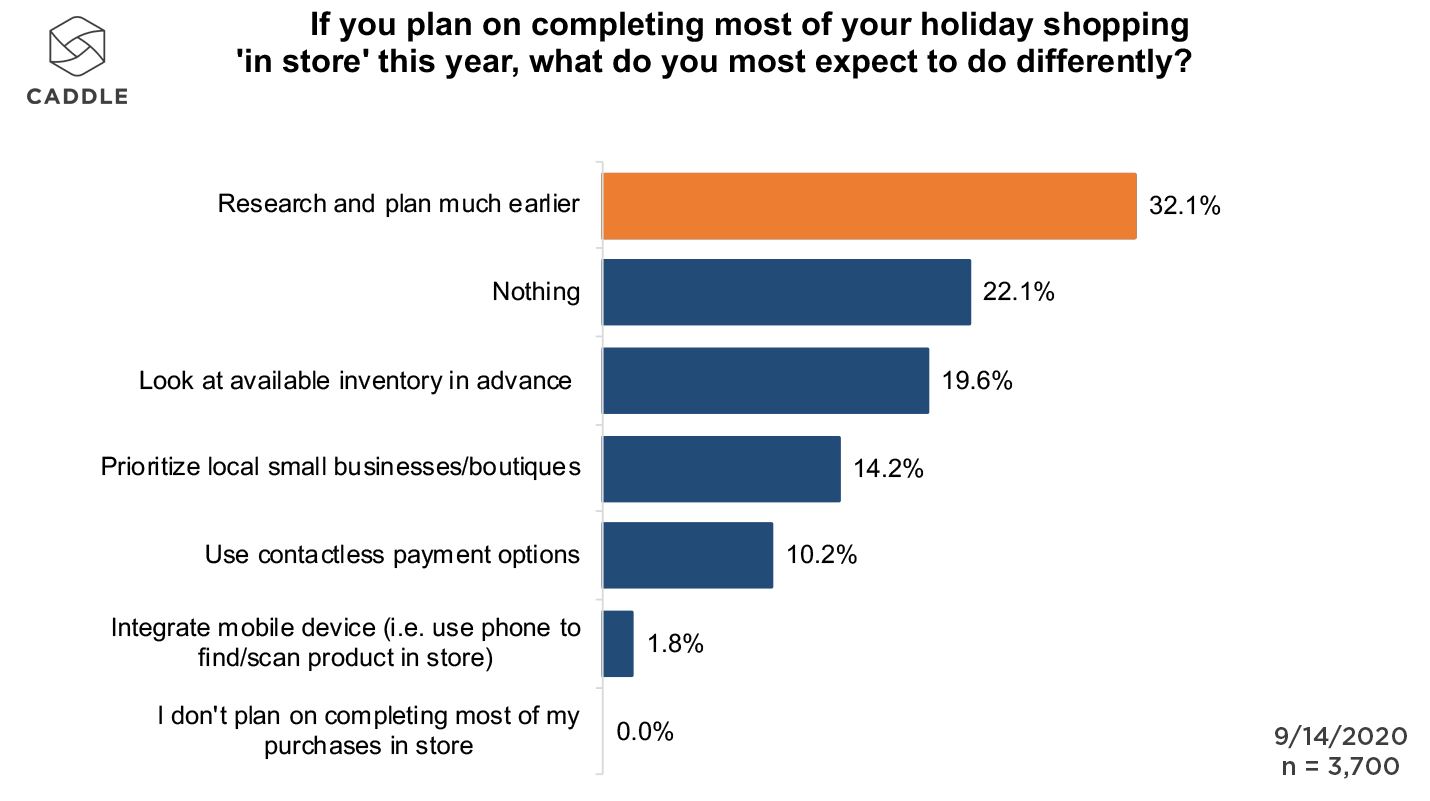
Canadians seem most interested in purchasing items that can deliver immediate gratification: Clothing and Accessories (39%), Electronics and Appliances (26%), and Health and Personal Care (13%) top the list of product categories they’re most interested in shopping for this coming holiday season, while understandably, given continued lockdown in cities across the country, Travel comes in last for all respondents, at 1.5%. (Likewise, in a separate Caddle Panel from later in September, nearly a third of respondents indicated that they planned to decrease spending in the fall/winter on Travel.)
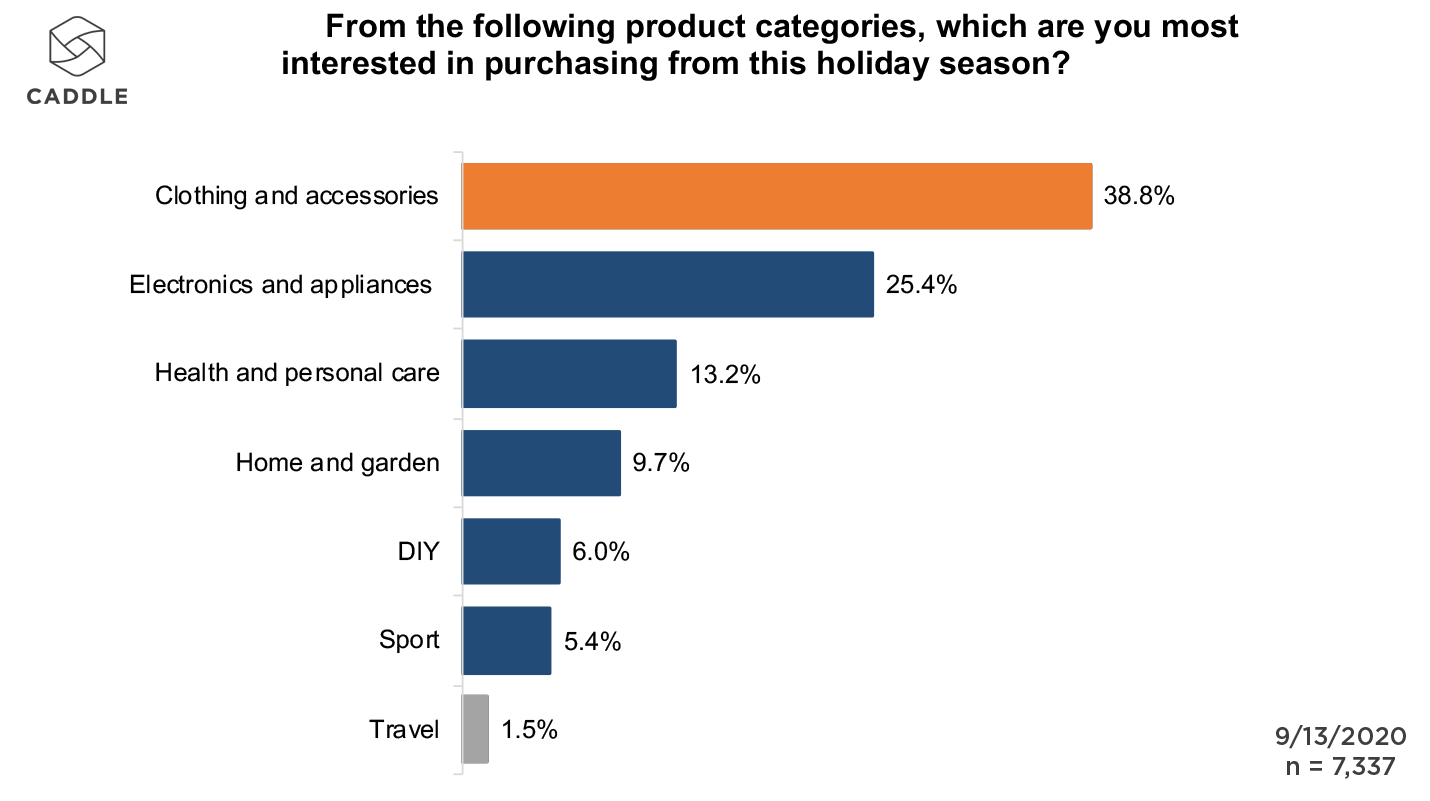
WHICH CHANNELS DO CANADIANS FAVOUR FOR THEIR SEASONAL SHOPPING IN 2020?
Canadian consumers are almost 2x more excited about Black Friday shopping than Boxing Day and Cyber Monday, and this seems to correlate with their preferred shopping locations.
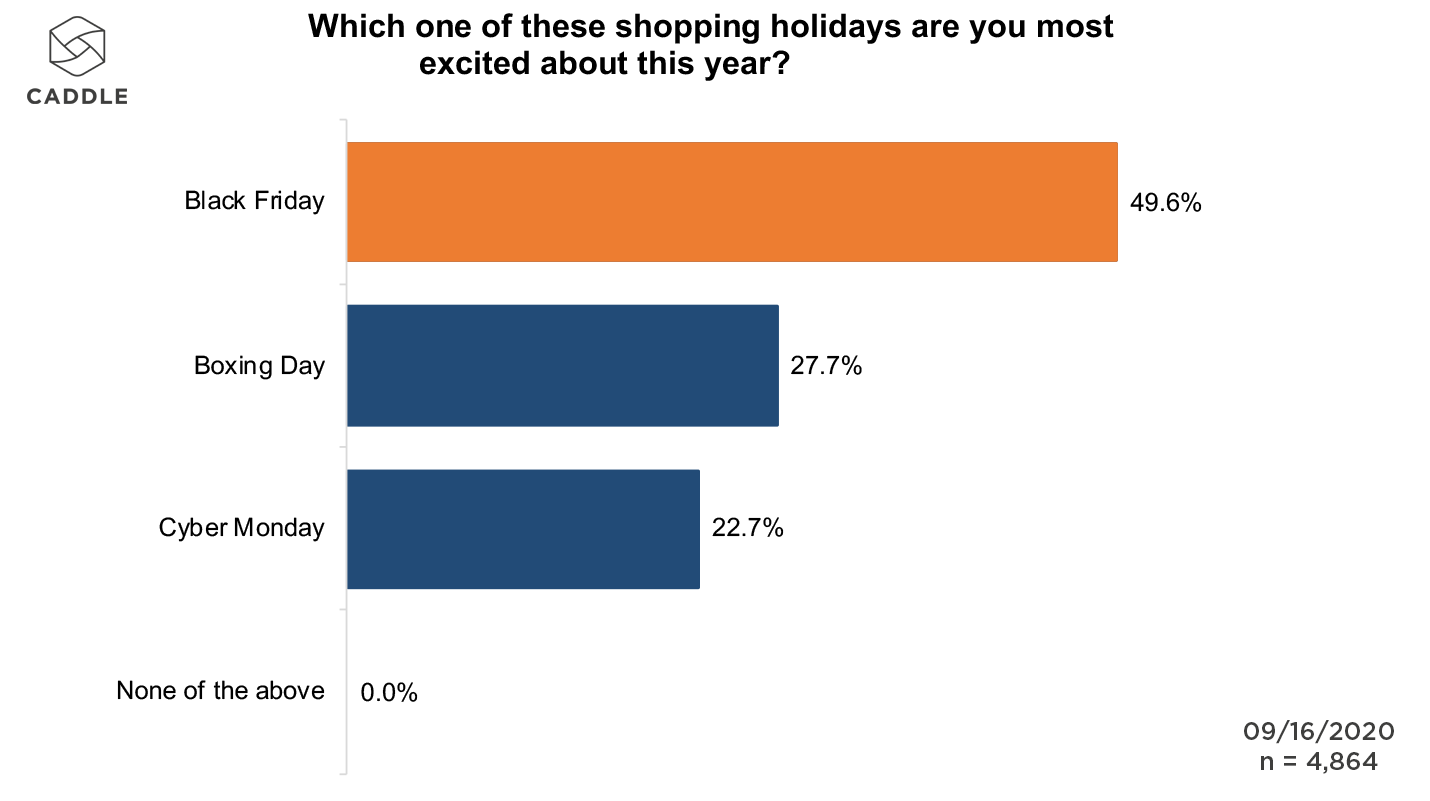
Based on our research, many consumers seem undeterred from visiting brick-and-mortar locations. On the one hand, among our Caddle users who were most excited about Black Friday and Boxing Day shopping opportunities, at least 40% are likely to shop at a brick-and-mortar location at least once over the holiday season. (Prince Edward Islanders are far and away the most likely, at 72%, while Quebeckers are least likely, at 38%.)
On the other hand, when it comes to the top categories of products they’d purchase (as outlined above), responses were mixed, and included “Mostly online with some in-store shopping” (34%), “Online and in-store equally” (22%), and “Mostly in-store with some online” (20%). In the meantime, “Online only” and “In-store only” ranked relatively lower and fairly equally matched, at 13% and 11% respectively.
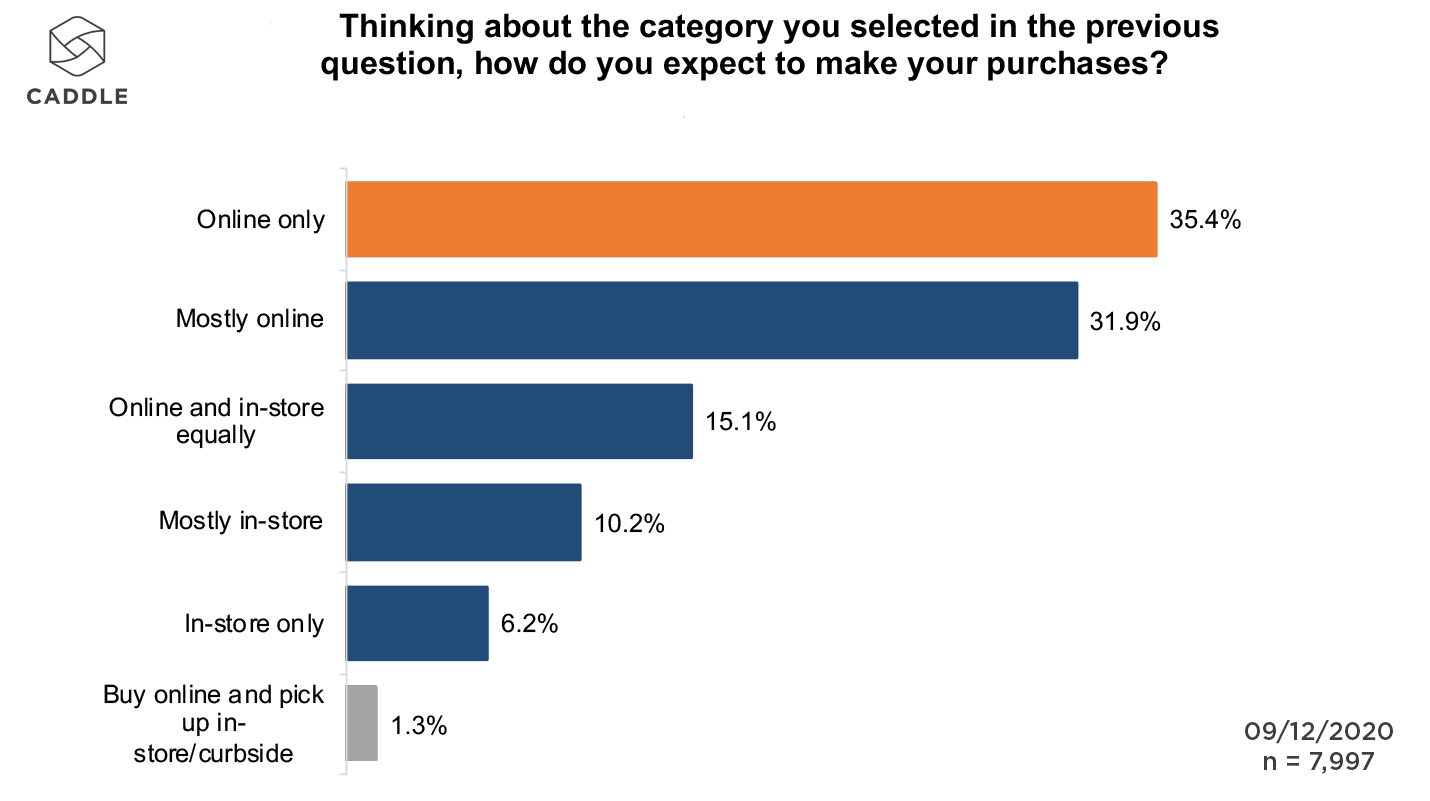
Interestingly, buy online, pickup in-store (BOPIS)/curbside hardly registers for these respondents. This could relate to the fact that winter weather can be unpredictable at best and downright nasty at worst—making a trip to pick up already purchased items a slog.
However, it’s a curious finding when we consider that among consumers who had completed most of their holiday purchases in-store in 2019, 56% were interested in shifting to BOPIS/curbside. This is particularly the case among Gen Zers from Newfoundland and Alberta (87.5% and 68%, respectively), as well as Prince Edward Islanders (60.8%), British Columbians (60.5%) and Newfoundlanders (59%) of all ages.
DO CANADIANS PLAN TO SPEND MORE OR LESS ON HOLIDAY SHOPPING THAN IN PREVIOUS YEARS?
Most Canadians plan to shop and spend “about the same” amount in the latter months of the year when compared to previous years.
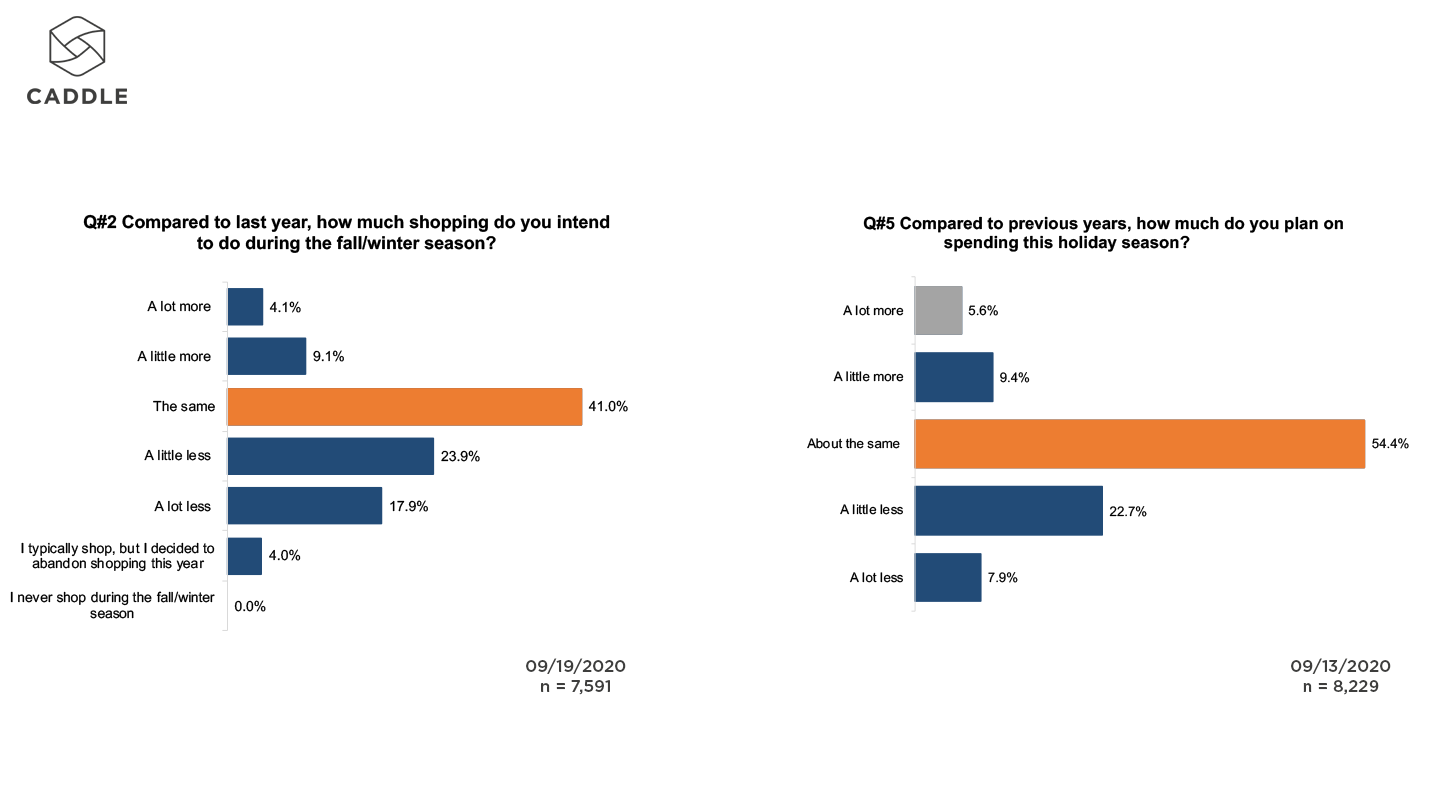
This comes as a bit of a surprise, as we learned elsewhere that nine in ten Canadians had tightened their budgets as a result of financial concerns driven by the pandemic. And it raises some important questions: Are more Canadians seeing the light at the end of the COVID tunnel? Or perhaps they feel like they’ve held back long enough and want to return to “normal,” at least for the holidays.
We may also find some insights in our panel’s thinking around “treating themselves”: A third of respondents said they had purchased a treat or a luxury item to keep their spirits up during the pandemic.
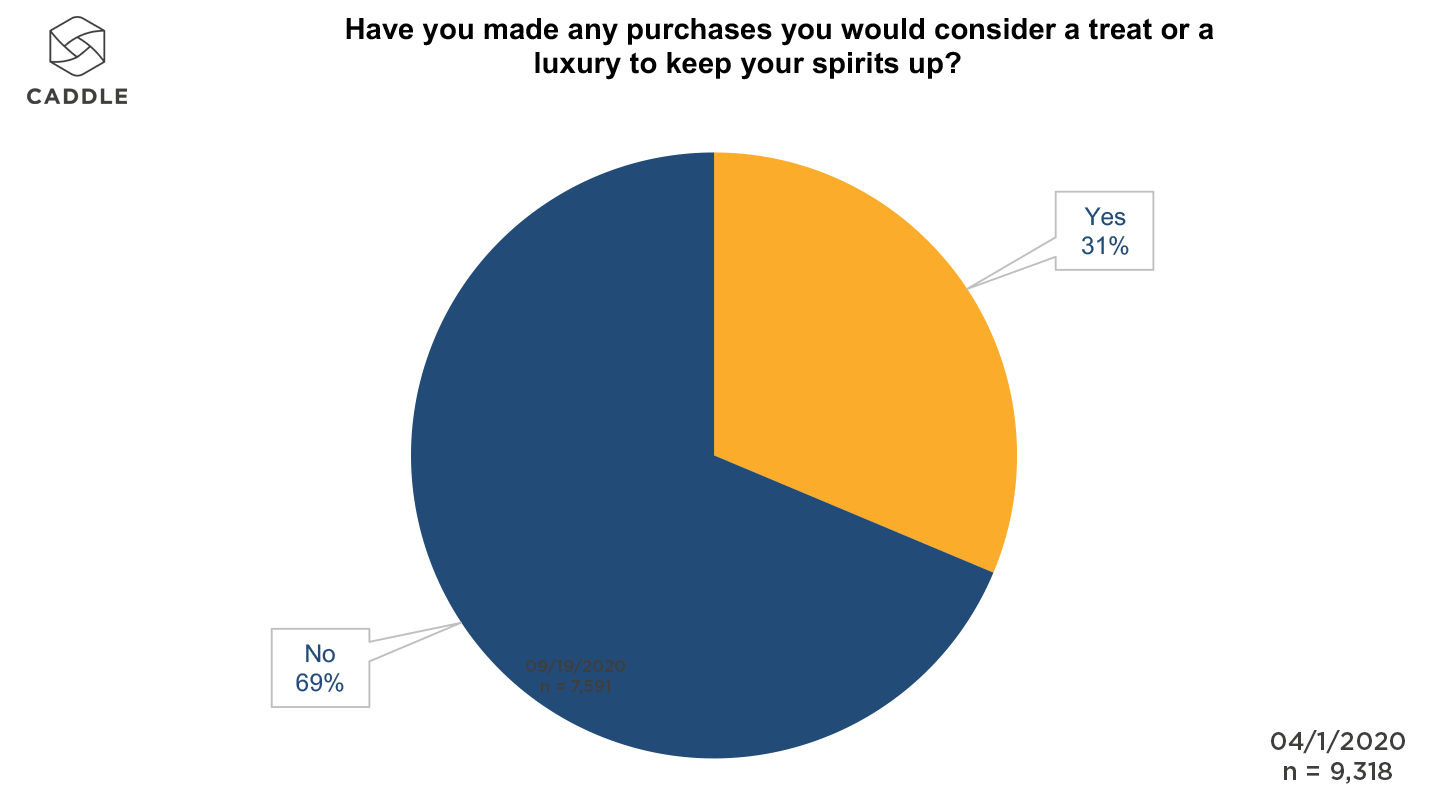
This finding dates back to the early days of the pandemic, and perhaps hints at the growing need for consumers to continue to “treat” themselves as a second wave of COVID cases is on our doorsteps.
At the same time, the majority of our Caddle users (70%) indicated they’d be more mindful about how much they’d spend this coming fall/winter—especially respondents from Ontario, Manitoba and New Brunswick (72% each), and Alberta (74%).
KEY TAKEAWAYS
PEOPLE ARE PLANNING AND SHOPPING FOR THE HOLIDAYS EVEN EARLIER THAN EXPECTED.
According to a recent Shopify webinar, Google data from 2019 indicated that shoppers had entered Black Friday/Cyber Monday week with more than a third of their shopping already completed. And by late August 2020, 1 in 4 shoppers had already started their holiday shopping.
With seasonal spending beginning earlier each year—and consumers primed for big deals because of Amazon and other online mega-retailer events—Canada’s retail sector needs to get ahead of the curve (and fast!) if they’re going to be able to take advantage of consumer interest in seasonal spending.
CANADIANS ARE OPEN TO DIFFERENT WAYS OF GETTING THEIR SEASONAL SHOPPING FIX.
The pandemic has caused significant changes to the way people get things done—and that’s fantastic news for retailers. Why? Because even those die-hard brick-and-mortar shoppers from holidays-past are now more willing than ever to consider online shopping or a hybrid (i.e., BOPIS).
Smart retailers will take advantage of this opportunity, and if they haven’t already gotten their omnichannel shopping and fulfillment plans squared away, will definitely want to do so well before winter hits and “in-store only” shopping becomes less desirable for many consumers.
SHOPPERS MAY BE NOSTALGIC FOR “BETTER TIMES” AND WILL KEEP UP THEIR SPENDING HABITS IN THE COMING HOLIDAY SEASON.
Though consumers continue to be conscious of the effects of COVID on their finances, they’re also still planning on shopping this coming holiday season—especially for particular categories, like clothing and accessories, electronics and appliances, and health and personal care items.
That’s great news for retailers who already stock these types of products. But it’s also a ripe opportunity for alternative banners to get ahead of the holiday spending season; consider integrating these coveted categories into your assortment to take advantage of Canadian consumer intent in the coming months.
